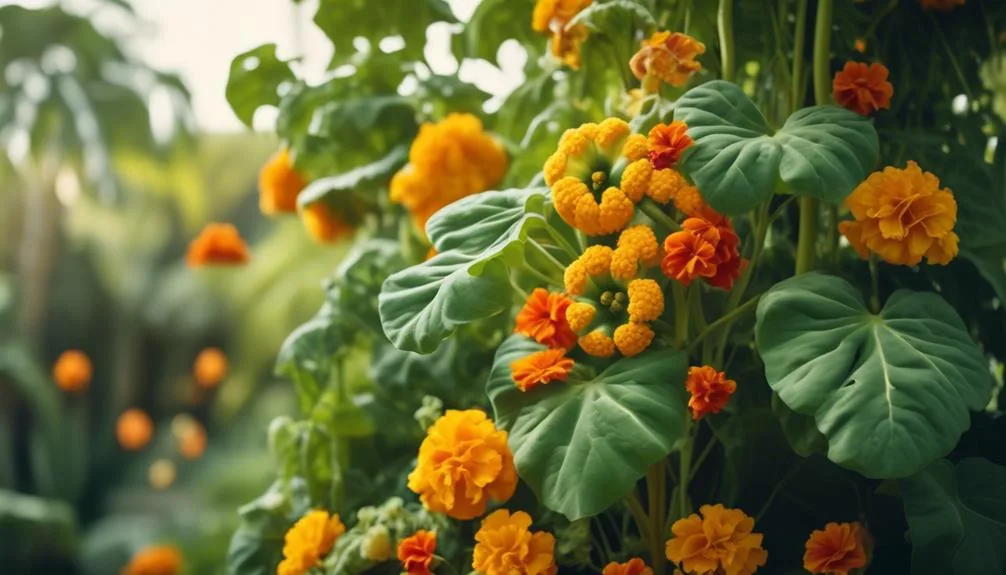Companion planting with papaya trees can boost their fruit yield by up to 20%.
Choosing the right companion plants is key to optimizing your papaya tree's growth.
From plants that enrich the soil to those that repel pests, there are many options to consider.
But which plants are the best companions for papaya trees, and how should you plant them for maximum benefit?
Let's explore the world of companion planting for papaya trees and find the perfect plant partners for your papaya orchard.
Key Takeaways
- Companion planting with papaya trees can increase fruit yield by up to 20%.
- Nitrogen-fixing plants, such as legumes, can naturally increase soil nitrogen levels and reduce the need for synthetic fertilizers.
- Planting pest-repelling plants, like marigolds and aromatic herbs, can create a natural barrier against harmful insects and pests.
- Shade-providing plants can create a favorable environment for papaya tree growth by shielding them from direct sunlight and contributing to soil fertility and moisture retention.
Benefits of Companion Plants
When selecting companion plants for your papaya trees, it's essential to consider the benefits they can provide, such as pest control, soil improvement, and overall plant health.
Certain companion plants contribute to soil enrichment, promoting healthier papaya tree growth. Leguminous plants like beans and peas are known to fix nitrogen in the soil, which is essential for plant growth.
Additionally, the concept of biodiversity is crucial for natural pest control. By planting a variety of flowers and herbs, you can attract beneficial insects like ladybugs and lacewings, which feed on pests that could otherwise harm your papaya trees. This natural pest control not only safeguards your papayas but also maintains the overall health of your garden ecosystem.
Nitrogen-Fixing Plants
Nitrogen-fixing plants play a crucial role in enhancing the soil quality for papaya trees, aiding in their overall growth and health. These plants have the remarkable ability to convert atmospheric nitrogen into a form that papaya trees can use, enriching the soil with this essential nutrient. This process reduces the need for synthetic fertilizers and promotes organic soil enrichment.
By incorporating nitrogen-fixing plants like legumes into your papaya tree garden, you can naturally increase the nitrogen levels in the soil, fostering a more balanced and sustainable ecosystem. Additionally, employing crop rotation and intercropping techniques with nitrogen-fixing plants can further optimize soil health, as different plants have varying nutrient needs and contributions.
This holistic approach supports the long-term vitality of your papaya trees while minimizing reliance on external inputs.
Pest-Repelling Plants
Enhance the health of your papaya trees by strategically incorporating pest-repelling plants into your garden.
Natural pest control is essential for maintaining the well-being of your papaya trees. By planting pest-repelling plants alongside your papaya trees, you can create a natural barrier against harmful insects and pests. Marigolds, for example, are known for their ability to repel nematodes and other soil-borne pests.
Additionally, companion plant benefits extend beyond pest control, as certain plants can also attract beneficial insects that prey on pests. Consider planting basil, mint, or lavender near your papaya trees to deter common pests such as aphids, ants, and mealybugs.
These aromatic herbs not only repel pests but also add fragrance and beauty to your garden, creating a harmonious and functional ecosystem for your papaya trees.
Shade-Providing Plants
Consider incorporating shade-providing plants around your papaya trees to create a favorable environment for their growth and development. The right shade-providing plants not only shield the papaya trees from direct sunlight but also contribute to soil fertility and moisture retention.
When choosing shade-providing plants, opt for sun-loving options that thrive in the same conditions as papaya trees. Proper plant spacing is crucial to ensure that the shade-providing plants don't compete with the papaya trees for nutrients and space.
Additionally, establishing a consistent watering schedule for both the papaya trees and shade-providing plants will help maintain an optimal growing environment.
Some excellent options for shade-providing plants include:
- Dwarf Cavendish Banana Plants
- Pineapple Plants
- Sweet Potatoes
- Cassava
- Ginger
Planting Techniques
To ensure successful growth and health of your papaya trees, it's important to employ effective planting techniques that promote optimal development and yield. When planting papaya trees, it's essential to consider the watering frequency and soil requirements to ensure their proper establishment and growth. Papaya trees thrive in well-draining soil with a slightly acidic to neutral pH level, typically ranging from 5.5 to 7.0. Additionally, they require consistent watering, especially during the initial stages of growth, to establish a strong root system. However, it's important to avoid waterlogging the soil, as this can lead to root rot. To provide a clear overview, here is a table summarizing the recommended planting techniques for papaya trees:
| Planting Techniques | Description |
|---|---|
| Watering frequency | Consistent, avoiding waterlogging |
| Soil requirements | Well-draining, slightly acidic to neutral pH (5.5-7.0) |
Conclusion
To create a thriving environment for your papaya trees, consider planting nitrogen-fixing, pest-repelling, and shade-providing companion plants.
This thoughtful selection won't only benefit the growth and health of your papaya trees but also contribute to a diverse and balanced garden ecosystem.
Happy planting and may your garden flourish with abundance!

